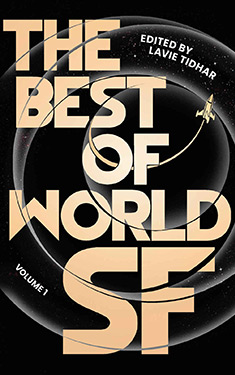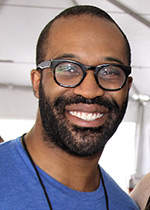
Added By: Administrator
Last Updated: Administrator
Hominids
| Author: | Robert J. Sawyer |
| Publisher: |
Analog Science Fiction and Fact, 2002 Tor, 2002 |
| Series: | The Neanderthal Parallax: Book 1 |
| Book Type: | Novel |
| Genre: | Science-Fiction |
| Sub-Genre Tags: | Alternate/Parallel Universe Human Development Near-Future |
| Awards: | |
| Lists: | |
| Links: |
|
| Avg Member Rating: |
|
|
|
|
Synopsis
Hominids is a strong, stand-alone SF novel, but it's also the first book of The Neanderthal Parallax, a trilogy that will examine two unique species of people. They are alien to each other, yet bound together by the never-ending quest for knowledge and, beneath their differences, a common humanity. We are one of those species, the other is the Neanderthals of a parallel world where they, not Homo sapiens, became the dominant intelligence. In that world, Neanderthal civilization has reached heights of culture and science comparable to our own, but is very different in history, society, and philosophy.
During a risky experiment deep in a mine in Canada, Ponter Boddit, a Neanderthal physicist, accidentally pierces the barrier between worlds and is transferred to our universe, where in the same mine another experiment is taking place. Hurt, but alive, he is almost immediately recognized as a Neanderthal, but only much later as a scientist. He is captured and studied, alone and bewildered, a stranger in a strange land. But Ponter is also befriended-by a doctor and a physicist who share his questing intelligence and boundless enthusiasm for the world's strangeness, and especially by geneticist Mary Vaughan, a lonely woman with whom he develops a special rapport.
Meanwhile, Ponter's partner, Adikor Huld, finds himself with a messy lab, a missing body, suspicious people all around, and an explosive murder trial that he can't possibly win because he has no idea what actually happened. Talk about a scientific challenge!
Contact between humans and Neanderthals creates a relationship fraught with conflict, philosophical challenge, and threat to the existence of one species or the other-or both-but equally rich in boundless possibilities for cooperation and growth on many levels, from the practical to the esthetic to the scientific to the spiritual. In short, Robert J. Sawyner has done it again.
Excerpt
Chapter One
DAY ONE
FRIDAY, AUGUST 2
148/118/24
The blackness was absolute.
Watching over it was Louise Benoit, twenty-eight, a statuesque postdoc from Montreal with a mane of thick brown hair stuffed, as required here, into a hair net. She kept her vigil in a cramped control room, buried two kilometers - "a mile an' a quarder," as she sometimes explained for American visitors in an accent that charmed them - beneath the Earth's surface.
The control room was next to the deck above the vast, unilluminated cavern housing the Sudbury Neutrino Observatory. Suspended in the center of that cavern was the world's largest acrylic sphere, twelve meters - "almost fordy feet" - across. The sphere was filled with eleven hundred tonnes of heavy water on loan from Atomic Energy of Canada Limited.
Enveloping that transparent globe was a geodesic array of stainless-steel struts, supporting 9,600 photomultiplier tubes, each cupped in a reflective parabola, each aimed in toward the sphere. All of this - the heavy water, the acrylic globe that contained it, and the enveloping geodesic shell - was housed in a ten-story-tall barrel-shaped cavern, excavated from the surrounding norite rock. And that gargantuan cavern was filled almost to the top with ultrapure regular water.
The two kilometers of Canadian shield overhead, Louise knew, protected the heavy water from cosmic rays. And the shell of regular water absorbed the natural background radiation from the small quantities of uranium and thorium in the surrounding rock, preventing that, too, from reaching the heavy water. Indeed, nothing could penetrate into the heavy water except neutrinos, those infinitesimal subatomic particles that were the subject of Louise's research. Trillions of neutrinos passed right through the Earth every second; in fact, a neutrino could travel through a block of lead a light-year thick with only a fifty-percent chance of hitting something.
Still, neutrinos poured out of the sun in such vast profusion that collisions did occasionally occur - and heavy water was an ideal target for such collisions. The hydrogen nuclei in heavy water each contain a proton - the normal constituent of a hydrogen nucleus - plus a neutron, as well. And when a neutrino did chance to hit a neutron, the neutron decayed, releasing a proton of its own, an electron, and a flash of light that could be detected by the photomultiplier tubes.
At first, Louise's dark, arching eyebrows did not rise when she heard the neutrino-detection alarm go ping, the alarm sounded briefly about a dozen times a day, and although it was normally the most exciting thing to happen down here, it still didn't merit looking up from her copy of Cosmopolitan.
But then the alarm sounded again, and yet again, and then it stayed on, a solid, unending electric bleep like a dying man's EKG.
Louise got up from her desk and walked over to the detector console. On top of it was a framed picture of Stephen Hawking - not signed, of course. Hawking had visited the Sudbury Neutrino Observatory for its grand opening a few years ago, in 1998. Louise tapped on the alarm's speaker, in case it was on the fritz, but the keening continued.
Paul Kiriyama, a scrawny grad student, dashed into the control room, arriving from elsewhere in the vast, underground facility. Paul was, Louise knew, usually quite flustered around her, but this time he wasn't at a loss for words. "What the heck's going on?" he asked. There was a grid of ninety-eight by ninety-eight LEDs on the detector panel, representing the 9,600 photomultiplier tubes; every one of them was illuminated.
"Maybe someone accidentally turned on the lights in the cavern," said Louise, sounding dubious even to herself.
The prolonged bleep finally stopped. Paul pressed a couple of buttons, activating five TV monitors slaved to five underwater cameras inside the observatory chamber. Their screens were perfectly black rectangles. "Well, if the lights were on," he said, "they're off now. I wonder what - "
"A supernova!" declared Louise, clapping her longfingered hands together. "We should contact the Central Bureau for Astronomical Telegrams; establish our priority." Although SNO had been built to study neutrinos from the sun, it could detect them from anywhere in the universe.
"Paul nodded and plunked himself down in front of a Web browser, clicking on the bookmark for the Bureau's site. It was worth reporting the event, Louise knew, even if they weren't yet sure.
A new series of pings sounded from the detector panel. Louise looked at the LED board; several hundred lights were illuminated all over the grid. Strange, she thought. A supernova should register as a directional source
"Maybe something's wrong with the equipment?" said Paul, clearly reaching the same conclusion. "Or maybe the connection to one of the photomultipliers is shorting out, and the others are picking up the arc."
The air split with a creaking, groaning sound, coming from next door - from the deck atop the giant detector chamber itself. "Perhaps we should turn on the chamber lights," said Louise. The groaning continued, a subterranean beast prowling in the dark.
"But what if it is a supernova?" said Paul. "The detector is useless with the lights on, and - "
Another loud cracking, like a hockey player making a slap shot. "Turn on the lights!"
Paul lifted the protective cover on the switch and pressed it. The images on the TV monitors flared then settled down, showing -
"Mon dieu," declared Louise.
"There're something inside the heavy-water tank!" said Paul. "But how could - ?"
"Did you see that?" said Louise. "It's moving, and - good Lord, it's a man!"
The cracking and groaning sounds continued, and then -
They could see it on the monitors and hear it coming through the walls.
The giant acrylic sphere burst apart along several of the seams that held its component pieces together. "Tabernacle," Louise swore, realizing the heavy water must now be mixing with the regular H2O inside the barrel-shaped chamber. Her heart was jackhammering. For half a second, she didn't know whether to be more concerned about the destruction of the detector or about the man who was obviously drowning inside it.
"Come on!" said Paul, heading for the door leading to the deck above the observatory chamber. The cameras were slaved to VCRs; nothing would be missed.
"Un moment," said Louise. She dashed across the control room, grabbed a telephone handset, and pounded out an extension from the list taped to the wall.
The phone rang twice. "Dr. Montego?" said Louise, when the Jamaican-accented voice of the mine-site physician came on. "Louise Benoit here, at SNO. We need you right away down at the neutrino observatory. There's a man drowning in the detector chamber."
"A man drowning?" said Montego. "But how could he possibly get in there?"
"We don't know. Hurry!"
"I'm on my way," said the doctor. Louise replaced the handset and ran toward the same blue door Paul had gone through earlier, which had since swung shut. She knew the signs on it by heart:
* * *
Keep Door Closed
Danger: High Voltage Cables
No Unauthorized Electronic Equipment Beyond This Point
Air Quality Checked - Cleared for Entry
* * *
Louise grabbed the handle, pulling the door open, and hurried onto the wide expanse of the metal deck.
There was a trapdoor off to one side leading down to the actual detector chamber; the final construction worker had exited through it, and had sealed it shut behind him. To Louise's astonishment, the trapdoor was still sealed by forty separate bolts - of course, it was supposed to be sealed, but there was no way a man could have gotten inside except through that trapdoor
The walls surrounding the deck were covered with dark green plastic sheeting to keep rock dust out. Dozens of conduits and polypropylene pipes hung from the ceiling, and steel girders sketched out the shape of the room. Computing equipment lined some walls; others had shelves. Paul was over by one of the latter, desperately rummaging around, presumably for pliers strong enough to crank the bolts free.
Metal screamed in anguish. Louise ran toward the trapdoor - not that there was anything she could do to unseal it with her bare hands. Her heart leapt; a sound like machine-gun fire erupted into the room as the restraining bolts shot into the air. The trapdoor burst open, slapping back on its hinges and hitting the deck with a reverberating clang. Louise had jumped out of the way, but a geyser of cold water leapt up through the opening, soaking her.
The very top of the detector chamber was filled with nitrogen gas, which Louise knew must be venting now. The water spout quickly subsided. She moved toward the opening in the deck and looked down, trying not to breathe. The interior was illuminated by the floodlights Paul had turned on, and the water was absolutely pure; Louise could see all the way to the bottom, thirty meters below.
She could just make out the giant curving sections of the acrylic sphere; the acrylic's index of refraction was almost identical to that of water, making it hard to see. The sections, separated from each other now, were anchored to the roof by synthetic-fiber cables; otherwise, they would have already sunk to the bottom of the surrounding geodesic shell. The trapdoor's opening gave only a limited perspective, and Louise couldn't yet see the drowning man.
"Merde!" The lights inside the chamber had gone off. "Paul!" Louise shouted. "What are you doing?"
Paul's voice - now coming from back in the control room - was barely audible above the air-conditioning equipment and the sloshing of the water in the huge cavern beneath Louise's feet. "If that man's still alive," he shouted, "he'll see the lights up on the deck through the trapdoor."
Louise nodded. The only thing the man would now be seeing was a single illuminated square, a meter on a side, in what, to him, would be a vast, dark ceiling.
A moment later, Paul returned to the deck. Louise looked at him, then back down at the open trapdoor. There was still no sign of the man. "One of us should go in," said Louise.
Paul's almond-shaped eyes went wide. "Butthe heavy water - "
"There's nothing else to do," said Louise. "How good a swimmer are you?"
Paul looked embarrassed; the last thing he ever wanted to do, Louise knew, was look bad in her eyes, but"Not very," he said, dropping his gaze.
It was already awkward enough down here with Paul mooning over her all the time, but Louise couldn't very well swim in her SNO-issue blue-nylon jumpsuit. Underneath, though, like almost everyone else who worked at SNO, she only had on her underwear; the temperature was a tropical 40.6 Celsius this far beneath Earth's surface. She yanked off her shoes, then pulled on the zipper that ran down the front of the jumpsuit; thank God she'd worn a bra today - although she wished now that it hadn't been as lacy.
"Turn the lights back on down there," said Louise. To his credit, Paul didn't tarry. Before he'd returned, Louise had slipped through the trapdoor into the cold water; the water was chilled to ten degrees Celsius to discourage biological growth and to reduce the spontaneous noise rate of the photomultiplier tubes.
She felt a rush of panic, a sudden feeling of being a long way up with nothing supporting her; the bottom was far, far below. She was treading water, her head and shoulders sticking up through the open trapdoor into the air, waiting for her panic to subside. When it did, she took three deep breaths, closed her mouth tight, and dived beneath the surface.
Louise could see clearly, and her eyes didn't sting at all. She looked around, trying to spot the man, but there were so many pieces of acrylic, and -
There he was.
He had indeed floated up, and there was a small gap - maybe fifteen centimeters - between the top of the water and the deck above. Normally it was filled with ultrapure nitrogen. The poor guy must be dead; three breaths of that would be fatal. A sad irony: he probably fought his way to the surface, thinking he could find air, only to be killed by the gas he inhaled there. Breathable air from the open trapdoor must now be mixing with the nitrogen, but presumably it was too late to help him.
Louise pushed her own head and shoulders up through the trapdoor again. She could see Paul, desperately waiting for her to say something - anything. But there was no time for that. She gulped more air, filling her lungs as much as she could, then dived under. There wasn't enough room for her to keep her nose above water without constantly banging her head into the metal roof as she swam. The man was about ten meters away. Louise kicked her feet, covering the distance as quickly as she could, and -
A cloud in the water. Something dark.
Mon dieu!
It was blood.
The cloud surrounded the man's head, obscuring his features. He wasn't moving at all; if he were still alive, he was surely unconscious.
Louise craned to get her mouth and nose into the air gap. She took one tentative breath - but there was plenty of breathable air there now - then grabbed the man's arm. Louise rolled the fellow over - he'd been floating facedown - so that his nose was sticking up into the air gap, but it seemed to make no difference. There was no spluttering from him, no sign that he was still breathing.
Louise dragged him through the water. It was tough work: the man was quite stocky, and he was fully dressed; his clothes were waterlogged. Louise didn't have time to notice much, but it did register on her that the man wasn't wearing coveralls or safety boots. He couldn't possibly be one of the nickel miners, and although Louise had only gotten a fleeting glimpse of the man's face - a white guy, blond beard - he wasn't from SNO, either.
Paul must have been crouching on the deck above. Louise could see his head sticking into the water; he was watching as Louise and the man came closer. Under other circumstances, Louise would have gotten the injured person out of the water before she herself left it, but the trapdoor was only big enough for one of them to go through at a time, and it would take both her and Paul to drag this large man out.
Louise let go of the man's arm and stuck her head up through the trapdoor, Paul having now backed off from it. She took a moment just to breathe; she was exhausted from pulling the man through the water. And then she put her palms flat on the wet deck and began to lift herself up and out. Paul crouched down again and helped Louise onto the deck, then they turned back to the man.
He had started to drift away, but Louise managed to grab his arm and drag him back under the opening. Louise and Paul then struggled to get him out, finally succeeding in lifting him onto the deck. He was still bleeding; the injury was clearly to the side of his head.
Paul immediately knelt next to the man and began administering mouth-to-mouth resuscitation, his cheek getting slick with blood each time he turned to see if the man's broad chest was rising.
Louise, meanwhile, found the man's right wrist and searched for a pulse. There didn't - no, no, wait! There was! There was a pulse.
Paul continued to blow air into the man's mouth, over and over again, and finally the man began to gasp on his own. Water and vomit came pouring out of him. Paul turned his head sideways, and the liquid he was ejecting mixed with the blood on the deck, washing some of it away.
The man still seemed to be unconscious, though. Louise, soaking wet, almost naked, and still chilled from the water, was starting to feel quite self-conscious. She struggled back into her jumpsuit and zipped it up - Paul watching her, she knew, even while he pretended not to.
It would still be a while before Dr. Montego arrived. SNO wasn't just two kilometers down; it was also a kilometer and a quarter horizontally from the nearest elevator, at mineshaft number nine. Even if the lift cage had been at the top-and there was no guarantee it would have been - it would still take Montego twenty-odd minutes to get here.
Louise thought she should get the man out of his wet clothes. She reached for the front of his charcoal gray shirt, but -
But there were no buttons - and no zipper. It didn't appear to be a pullover, even though it was collarless, and -
Ah, there they were! Hidden snaps running along the tops of the broad shoulders. Louise tried to undo them, but they didn't budge. She glanced down at the man's pants. They seemed to be dark olive green, although they might have been much lighter if dry. But there was no belt; instead, a series of snaps and folds encircled the waist.
It suddenly occurred to Louise that the man might be suffering from the bends. The detector chamber was thirty meters deep; who knew how far down he'd gone or how quickly he'd come up? Air pressure this much below Earth's surface was 130 percent of normal. At that moment, Louise couldn't figure out how that would affect whether someone got the bends, but it did mean the man would now be receiving a higher concentration of oxygen than he would have up top, and that surely must be to the good.
There was nothing to do now but wait; the man was breathing, and his pulse had strengthened. Louise finally had a chance to really look at the stranger's face. It was broad but not flat; rather, the cheekbones trailed back at an angle. And his nose was gargantuan, almost the size of a clenched fist. The man's lower jaw was covered by a thick, dark blond beard, and straight blond hair was plastered across his forehead. His facial features were vaguely Eastern European, but with Scandinavian rather than olive coloring. The wide-spaced eyes were closed.
"Where could he possibly have come from?" asked Paul, now sitting cross-legged on the deck next to the man. "No one should have been able to get down here, and - "
Louise nodded. "And even if he could, how would he get inside the sealed detector chamber?" She paused and brushed hair out of her eyes - realizing for the first time that she'd lost her hair net while swimming in the tank. "You know, the heavy water is ruined. If he survives this stunt, he'll face one heck of a lawsuit."
Louise found herself shaking her head. Who could this man be, anyway? Maybe a Native Canadian zealot - an Indian who felt the mining was interfering with sacred ground. But the man's hair was blond, rare among Natives. Nor was this a youthful prank gone bad; the guy looked to be about thirty-five.
It was possible he was a terrorist or an antinuclear protester. But although Atomic Energy of Canada Limited had indeed supplied the heavy water, there was no nuclear work done at this site.
Whoever he was, Louise reflected, if he did finally die from his injuries, he'd be a prime candidate for the Darwin Awards. This was classic evolution-in-action stuff: a person who did something so incredibly stupid it cost him his own life.
Copyright © 2002 by Robert J. Sawyer
Reviews
Images
No alternate cover images currently exist for this novel.



















 Full Details
Full Details






